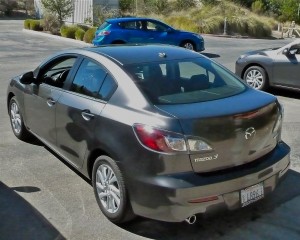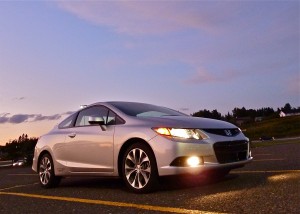Mazda3 shoots for the ‘Skyactiv’
By John Gilbert
HOLLYWOOD, CALIF. — Mazda’s new “Skyactiv†technology combines something old, a lot of new, and — without stepping on the tradition of the current Mazda3 — pulls off a complete holistic renovation of the company’s most successful model for 2012.
It is a signal of the modernization of Mazda’s car-building future, at the same time, because the Mazda3 compact represents 40 percent of all Mazda business in the U.S., where half of the 3-million-plus Mazda3s have been sold since the car replaced the Protege for the 2004 model year. The car underwent a full makeover for 2010, so the new model’s look is altered only slightly. But it is vastly changed beneath the skin.
To introduce the new car and its radical technology, Mazda chose the Hollywood Roosevelt Hotel, which, compared to the ultramodern locations usually chosen for new-car introductions, may have seemed an unusual site. But the hotel, like the car, has been completely renovated, with a unique combination of modern amenities while retaining a connection to the Roosevelt’s rich history, which is reflected on every floor and in every room. The hospitality suite Mazda used for the assembled auto journalists was, in fact, where Marilyn Monroe actually resided for three years. Reports persist that some guests in recent years have claimed that a room or two are occasionally visited by the friendly spirits of past residents.
Similarly, Mazda, which has a tradition of no-compromise performance, has completed the thorough renovation of the 2012 Mazda3 without losing touch with the car’s historic stature. Mazda’s all-consuming approach to modernizing the car upgrades Mazda3 fuel-efficiency to the 40-miles-per-gallon range rather than 30, while expanding its tradition of enjoyable and affordable performance. The look remains very similar, but the new and progressive Skyactiv technology alters its engines, transmissions, chassis structure, electronic connectivity features, aerodynamic efficiency on the outside, and improved ergonomics of the design inside.
Climbing inside both the Mazda3 sedan and hatchback, with both the stick and automatic, and driving down Hollywood Boulevard and up through the hills to Rochester Ranch, and back, gave us the opportunity to run the cars, and some competitors, through all the paces of urban, rural, mountain and freeway driving. Performance was typically quick and agile, the new engine and transmissions brought the tightness of the car to life, and the steering and suspension, and even the simplified instrumentation, seemed totally coordinated.
Mazda has never approached the hefty sales figures of Toyota, Honda or Nissan among its Japanese rivals, but its cars often attained better fuel economy and always have stressed being sportier to drive. Japanese manufacturers moved to the top of the industry with models capable of 30-miles-per-gallon a couple of decades ago. They might have been satisfied with that, leaving room for other companies, most notably Korea’s Hyundai, to lead the charge to make 40 the new 30 for contemporary gasoline-engine fuel economy potential. The Ford Focus and Fiesta, and the Chevrolet Cruze offer new models that will hit 40, forcing Honda, Toyota and Nissan to hustle out with special versions of current models to reach 40 with specially tweaked existing engines. Read more
To make new Civic stand out, just say ‘Si’
By John Gilbert
Do you like Honda Civics? The best answer is to just say “Si.â€
For reasons known best to Honda, the designation for the sporty model of the Civic in this alpha-numeric world is the “SI,†except that instead of using two capital letters, Honda uses a lower-case “i,†making it “Si.†Regardless, the Civic Si commands a hearty “Si!†to anyone who experiences it. It is both fun to drive and surprisingly economical when it’s driven aggressively. Which is easy to do.
It can even overcome any lingering disappointment the regular 2012 Civic may have caused by making only very subtle styling tweaks, with none of the high-tech advances in engines or transmissions to keep up with the competition.
Since the 2006 Civic made a radical styling change, the new car didn’t really need major reshaping. The powertrain, however, is an aging story in the non-Si Civics. Honda’s legendary VTEC variable valve-timing system put the Civic a notch up on everybody since introduced in 1991, leaving the competition striving to make up the deficit ever since.Â
For the 2012 model year, the Civic’s competition has intensified. New Ford Focus and Fiesta, and Chevrolet Cruze, plus the revised and repositioned Volkswagen Jetta, a new Nissan Versa, and a much-improved and entirely redone Hyundai Elantra lead the charge. Not only have some or all of them caught up in technology, some have gone beyond, with features such as direct injection, and coordinating new 6-speed transmissions to better-dispense the power.
In the face of all that, the 2012 Civic stayed with the same, but aging, 1.8-liter engine, with 16 valves and a smooth but unexciting single overhead-camshaft design, and the same smooth but limited 5-speed stick or 5-speed automatic. That combination delivers 140 horsepower and 128 foot-pounds of torque.
The previous Si model was an impressive departure, coming in coupe and sedan, with a 2.0-liter 4-cylinder with dual-overhead cams and a tachometer redline of 7,800 RPMs. It was the ideal small but overachieving engine. Some complained that you had to run the revs up to get at most of the power; my impression was that you could run the revs up, because they soared to such race-car-like levels. Honda was ahead of what other companies are only now trying to implement, and yet Honda has abandoned it. Read more
Budget convertibles meet top-down demands

The Mazda MX-5 Miata brings the pleasure of traditional British roadsters to contemporary trouble-free motoring.
By John Gilbert
Ah, Indian Summer. Or does our recent political correctness require us to call it “Native American Summer?†In any case, it’s that wonderful stretch of autumn that comes after September, when the temperatures make one more summer-like climb after the leaves already have changed color and started falling in wind-blown disarray.
Those of us who live where it snows in earnest can enjoy Indian Summer more than those from more temperate climes, and one of the greatest features of the annual late warm-up is the reappearance of convertibles. Yes, we thought we’d seen the last of drop-top, open-air vehicles when the first chill followed traditional summer, but right here in Minnesota, record temperatures in the 80s and even 90s visited in mid-October, and top-down driving made its usual reappearance.
When my mind wanders to the perfect scenario of a convertible, it is of a top-down roadster approaching around a gentle curve, sweeping past, and disappearing, leaving only a flurry of fallen leaves fluttering in its wake.
An earlier column gave an overview of various luxury convertibles, including the Jaguar XK, the BMW 6-Series, the Corvette, and the Mustang-challenging Camaros. But there are more, many more, taking advantage of the current trend toward specialty cars, and not all of them cost from $40,000 to $120,000. There are some convertibles-on-a-budget that meet all the requirements of open-air enjoyment, while also delivering impressive fuel economy, and starting at a price that any new-car budget could manage. Read more




 John Gilbert is a lifetime Minnesotan and career journalist, specializing in cars and sports during and since spending 30 years at the Minneapolis Tribune, now the Star Tribune. More recently, he has continued translating the high-tech world of autos and sharing his passionate insights as a freelance writer/photographer/broadcaster. A member of the prestigious North American Car and Truck of the Year jury since 1993. John can be heard Monday-Friday from 9-11am on 610 KDAL(www.kdal610.com) on the "John Gilbert Show," and writes a column in the Duluth Reader.
John Gilbert is a lifetime Minnesotan and career journalist, specializing in cars and sports during and since spending 30 years at the Minneapolis Tribune, now the Star Tribune. More recently, he has continued translating the high-tech world of autos and sharing his passionate insights as a freelance writer/photographer/broadcaster. A member of the prestigious North American Car and Truck of the Year jury since 1993. John can be heard Monday-Friday from 9-11am on 610 KDAL(www.kdal610.com) on the "John Gilbert Show," and writes a column in the Duluth Reader.